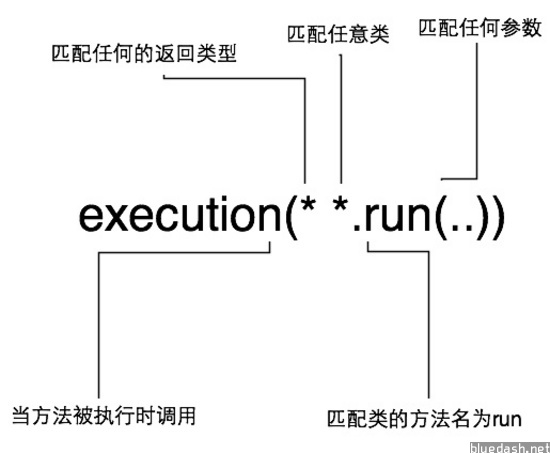дёҖгҖҒд»Җд№ҲжҳҜ AOP
йқўеҗ‘еҲҮйқўзј–зЁӢпјҲAOPпјүжҸҗдҫӣеҸҰеӨ–дёҖз§Қи§’еәҰжқҘжҖқиҖғзЁӢеәҸз»“жһ„пјҢйҖҡиҝҮиҝҷз§Қж–№ејҸејҘиЎҘдәҶйқўеҗ‘еҜ№иұЎзј–зЁӢпјҲOOPпјүзҡ„дёҚи¶ігҖӮ йҷӨдәҶзұ»пјҲclassesпјүд»ҘеӨ–пјҢAOPжҸҗдҫӣдәҶеҲҮйқўгҖӮеҲҮйқўеҜ№е…іжіЁзӮ№иҝӣиЎҢжЁЎеқ—еҢ–пјҢдҫӢеҰӮжЁӘеҲҮеӨҡдёӘзұ»еһӢе’ҢеҜ№иұЎзҡ„дәӢеҠЎз®ЎзҗҶгҖӮ пјҲиҝҷдәӣе…іжіЁзӮ№жңҜиҜӯйҖҡеёёз§°дҪңВ жЁӘеҲҮпјҲcrosscuttingпјүВ е…іжіЁзӮ№гҖӮпјү
Springзҡ„дёҖдёӘе…ій”®зҡ„组件е°ұжҳҜВ AOPжЎҶжһ¶гҖӮ е°Ҫз®ЎеҰӮжӯӨпјҢSpring IoCе®№еҷЁе№¶дёҚдҫқиө–дәҺAOPпјҢиҝҷж„Ҹе‘ізқҖдҪ еҸҜд»ҘиҮӘз”ұйҖүжӢ©жҳҜеҗҰдҪҝз”ЁAOPпјҢAOPжҸҗдҫӣејәеӨ§зҡ„дёӯй—ҙ件解еҶіж–№жЎҲпјҢиҝҷдҪҝеҫ—Spring IoCе®№еҷЁжӣҙеҠ е®Ңе–„гҖӮ
В
дәҢгҖҒAOPзӣёе…ійҮҚиҰҒжҰӮеҝөпјҲеҝ…йЎ»зҗҶи§Јпјү
-
еҲҮйқўпјҲAspectпјүпјҡ дёҖдёӘе…іжіЁзӮ№зҡ„жЁЎеқ—еҢ–пјҢиҝҷдёӘе…іжіЁзӮ№еҸҜиғҪдјҡжЁӘеҲҮеӨҡдёӘеҜ№иұЎгҖӮдәӢеҠЎз®ЎзҗҶжҳҜJ2EEеә”з”ЁдёӯдёҖдёӘе…ідәҺжЁӘеҲҮе…іжіЁзӮ№зҡ„еҫҲеҘҪзҡ„дҫӢеӯҗгҖӮ еңЁSpring AOPдёӯпјҢеҲҮйқўеҸҜд»ҘдҪҝз”ЁйҖҡз”Ёзұ»пјҲеҹәдәҺжЁЎејҸзҡ„йЈҺж јпјү жҲ–иҖ…еңЁжҷ®йҖҡзұ»дёӯд»ҘВ @AspectВ жіЁи§ЈпјҲ@AspectJйЈҺж јпјүжқҘе®һзҺ°гҖӮ
-
иҝһжҺҘзӮ№пјҲJoinpointпјүпјҡ еңЁзЁӢеәҸжү§иЎҢиҝҮзЁӢдёӯжҹҗдёӘзү№е®ҡзҡ„зӮ№пјҢжҜ”еҰӮжҹҗж–№жі•и°ғз”Ёзҡ„ж—¶еҖҷжҲ–иҖ…еӨ„зҗҶејӮеёёзҡ„ж—¶еҖҷгҖӮ еңЁSpring AOPдёӯпјҢдёҖдёӘиҝһжҺҘзӮ№жҖ»жҳҜВ д»ЈиЎЁдёҖдёӘж–№жі•зҡ„жү§иЎҢгҖӮ йҖҡиҝҮеЈ°жҳҺдёҖдёӘВ org.aspectj.lang.JoinPointВ зұ»еһӢзҡ„еҸӮж•°еҸҜд»ҘдҪҝйҖҡзҹҘпјҲAdviceпјүзҡ„дё»дҪ“йғЁеҲҶиҺ·еҫ—иҝһжҺҘзӮ№дҝЎжҒҜгҖӮ
-
йҖҡзҹҘпјҲAdviceпјүпјҡ еңЁеҲҮйқўзҡ„жҹҗдёӘзү№е®ҡзҡ„иҝһжҺҘзӮ№пјҲJoinpointпјүдёҠжү§иЎҢзҡ„еҠЁдҪңгҖӮйҖҡзҹҘжңүеҗ„з§Қзұ»еһӢпјҢе…¶дёӯеҢ…жӢ¬вҖңaround гҖҗзҺҜз»•гҖ‘вҖқгҖҒвҖңbeforeгҖҗеүҚзҪ®гҖ‘вҖқе’ҢвҖңafterгҖҗеҗҺзҪ®гҖ‘вҖқзӯүйҖҡзҹҘгҖӮ йҖҡзҹҘзҡ„зұ»еһӢе°ҶеңЁеҗҺйқўйғЁеҲҶиҝӣиЎҢи®Ёи®әгҖӮи®ёеӨҡAOPжЎҶжһ¶пјҢеҢ…жӢ¬SpringпјҢйғҪжҳҜд»ҘжӢҰжҲӘеҷЁеҒҡйҖҡзҹҘжЁЎеһӢпјҢ并з»ҙжҠӨдёҖдёӘд»ҘиҝһжҺҘзӮ№дёәдёӯеҝғзҡ„жӢҰжҲӘеҷЁй“ҫгҖӮ
-
еҲҮе…ҘзӮ№пјҲPointcutпјүпјҡ еҢ№й…ҚиҝһжҺҘзӮ№пјҲJoinpointпјүзҡ„ж–ӯиЁҖгҖӮйҖҡзҹҘе’ҢдёҖдёӘеҲҮе…ҘзӮ№иЎЁиҫҫејҸе…іиҒ”пјҢ并еңЁж»Ўи¶іиҝҷдёӘеҲҮе…ҘзӮ№зҡ„иҝһжҺҘзӮ№дёҠиҝҗиЎҢпјҲдҫӢеҰӮпјҢеҪ“жү§иЎҢжҹҗдёӘзү№е®ҡеҗҚз§°зҡ„ж–№жі•ж—¶пјүгҖӮ еҲҮе…ҘзӮ№иЎЁиҫҫејҸеҰӮдҪ•е’ҢиҝһжҺҘзӮ№еҢ№й…ҚжҳҜAOPзҡ„ж ёеҝғпјҡSpringзјәзңҒдҪҝз”ЁAspectJеҲҮе…ҘзӮ№иҜӯжі•гҖӮ
-
еј•е…ҘпјҲIntroductionпјүпјҡ пјҲд№ҹиў«з§°дёәеҶ…йғЁзұ»еһӢеЈ°жҳҺпјҲinter-type declarationпјүпјүгҖӮеЈ°жҳҺйўқеӨ–зҡ„ж–№жі•жҲ–иҖ…жҹҗдёӘзұ»еһӢзҡ„еӯ—ж®өгҖӮ Springе…Ғи®ёеј•е…Ҙж–°зҡ„жҺҘеҸЈпјҲд»ҘеҸҠдёҖдёӘеҜ№еә”зҡ„е®һзҺ°пјүеҲ°д»»дҪ•иў«д»ЈзҗҶзҡ„еҜ№иұЎгҖӮ дҫӢеҰӮпјҢдҪ еҸҜд»ҘдҪҝз”ЁдёҖдёӘеј•е…ҘжқҘдҪҝbeanе®һзҺ°В IsModifiedВ жҺҘеҸЈпјҢд»Ҙдҫҝз®ҖеҢ–зј“еӯҳжңәеҲ¶гҖӮ
-
зӣ®ж ҮеҜ№иұЎпјҲTarget Objectпјүпјҡ иў«дёҖдёӘжҲ–иҖ…еӨҡдёӘеҲҮйқўпјҲaspectпјүжүҖйҖҡзҹҘпјҲadviseпјүзҡ„еҜ№иұЎгҖӮд№ҹжңүдәәжҠҠе®ғеҸ«еҒҡВ иў«йҖҡзҹҘпјҲadvisedпјүВ еҜ№иұЎгҖӮ 既然Spring AOPжҳҜйҖҡиҝҮиҝҗиЎҢж—¶д»ЈзҗҶе®һзҺ°зҡ„пјҢиҝҷдёӘеҜ№иұЎж°ёиҝңжҳҜдёҖдёӘВ иў«д»ЈзҗҶпјҲproxiedпјүВ еҜ№иұЎгҖӮ
-
AOPд»ЈзҗҶпјҲAOP Proxyпјүпјҡ AOPжЎҶжһ¶еҲӣе»әзҡ„еҜ№иұЎпјҢз”ЁжқҘе®һзҺ°еҲҮйқўеҘ‘зәҰпјҲaspect contractпјүпјҲеҢ…жӢ¬йҖҡзҹҘж–№жі•жү§иЎҢзӯүеҠҹиғҪпјүгҖӮ еңЁSpringдёӯпјҢAOPд»ЈзҗҶеҸҜд»ҘжҳҜJDKеҠЁжҖҒд»ЈзҗҶжҲ–иҖ…CGLIBд»ЈзҗҶгҖӮВ жіЁж„ҸпјҡSpring 2.0жңҖж–°еј•е…Ҙзҡ„еҹәдәҺжЁЎејҸпјҲschema-basedпјүйЈҺж је’Ң@AspectJжіЁи§ЈйЈҺж јзҡ„еҲҮйқўеЈ°жҳҺпјҢеҜ№дәҺдҪҝз”ЁиҝҷдәӣйЈҺж јзҡ„з”ЁжҲ·жқҘиҜҙпјҢд»ЈзҗҶзҡ„еҲӣе»әжҳҜйҖҸжҳҺзҡ„гҖӮ
-
з»Үе…ҘпјҲWeavingпјүпјҡ жҠҠеҲҮйқўпјҲaspectпјүиҝһжҺҘеҲ°е…¶е®ғзҡ„еә”з”ЁзЁӢеәҸзұ»еһӢжҲ–иҖ…еҜ№иұЎдёҠпјҢ并еҲӣе»әдёҖдёӘиў«йҖҡзҹҘпјҲadvisedпјүзҡ„еҜ№иұЎгҖӮ иҝҷдәӣеҸҜд»ҘеңЁзј–иҜ‘ж—¶пјҲдҫӢеҰӮдҪҝз”ЁAspectJзј–иҜ‘еҷЁпјүпјҢзұ»еҠ иҪҪж—¶е’ҢиҝҗиЎҢж—¶е®ҢжҲҗгҖӮ Springе’Ңе…¶д»–зәҜJava AOPжЎҶжһ¶дёҖж ·пјҢеңЁиҝҗиЎҢж—¶е®ҢжҲҗз»Үе…ҘгҖӮ
йҖҡзҹҘзҡ„зұ»еһӢпјҡ
-
еүҚзҪ®йҖҡзҹҘпјҲBefore adviceпјүпјҡ еңЁжҹҗиҝһжҺҘзӮ№пјҲjoin pointпјүд№ӢеүҚжү§иЎҢзҡ„йҖҡзҹҘпјҢдҪҶиҝҷдёӘйҖҡзҹҘдёҚиғҪйҳ»жӯўиҝһжҺҘзӮ№еүҚзҡ„жү§иЎҢпјҲйҷӨйқһе®ғжҠӣеҮәдёҖдёӘејӮеёёпјүгҖӮ
-
иҝ”еӣһеҗҺйҖҡзҹҘпјҲAfter returning adviceпјүпјҡ еңЁжҹҗиҝһжҺҘзӮ№пјҲjoin pointпјүжӯЈеёёе®ҢжҲҗеҗҺжү§иЎҢзҡ„йҖҡзҹҘпјҡдҫӢеҰӮпјҢдёҖдёӘж–№жі•жІЎжңүжҠӣеҮәд»»дҪ•ејӮеёёпјҢжӯЈеёёиҝ”еӣһгҖӮ
-
жҠӣеҮәејӮеёёеҗҺйҖҡзҹҘпјҲAfter throwing adviceпјүпјҡ еңЁж–№жі•жҠӣеҮәејӮеёёйҖҖеҮәж—¶жү§иЎҢзҡ„йҖҡзҹҘгҖӮ
-
еҗҺйҖҡзҹҘпјҲAfter (finally) adviceпјүпјҡ еҪ“жҹҗиҝһжҺҘзӮ№йҖҖеҮәзҡ„ж—¶еҖҷжү§иЎҢзҡ„йҖҡзҹҘпјҲдёҚи®әжҳҜжӯЈеёёиҝ”еӣһиҝҳжҳҜејӮеёёйҖҖеҮәпјүгҖӮ
-
зҺҜз»•йҖҡзҹҘпјҲAround Adviceпјүпјҡ еҢ…еӣҙдёҖдёӘиҝһжҺҘзӮ№пјҲjoin pointпјүзҡ„йҖҡзҹҘпјҢеҰӮж–№жі•и°ғз”ЁгҖӮиҝҷжҳҜжңҖејәеӨ§зҡ„дёҖз§ҚйҖҡзҹҘзұ»еһӢгҖӮ зҺҜз»•йҖҡзҹҘеҸҜд»ҘеңЁж–№жі•и°ғз”ЁеүҚеҗҺе®ҢжҲҗиҮӘе®ҡд№үзҡ„иЎҢдёәгҖӮе®ғд№ҹдјҡйҖүжӢ©жҳҜеҗҰ继з»ӯжү§иЎҢиҝһжҺҘзӮ№жҲ–зӣҙжҺҘиҝ”еӣһе®ғ们иҮӘе·ұзҡ„иҝ”еӣһеҖјжҲ–жҠӣеҮәејӮеёёжқҘз»“жқҹжү§иЎҢгҖӮ
дёүгҖҒspring Aopзҡ„е®һзҺ°
Spring жңүеҰӮдёӢдёӨз§ҚйҖүжӢ©жқҘе®ҡд№үеҲҮе…ҘзӮ№е’ҢеўһејәеӨ„зҗҶгҖӮ
В В В 1.еҹәдәҺ Annotation зҡ„вҖңйӣ¶й…ҚзҪ®вҖқж–№ејҸпјҡдҪҝз”Ё@AspectгҖҒ@Pointcutзӯү Annotation жқҘж ҮжіЁеҲҮе…ҘзӮ№е’ҢеўһејәеӨ„зҗҶгҖӮ
- В В В В 2.еҹәдәҺ XML й…ҚзҪ®ж–Ү件зҡ„з®ЎзҗҶж–№ејҸпјҡдҪҝз”Ё Spring й…ҚзҪ®ж–Ү件жқҘе®ҡд№үеҲҮе…ҘзӮ№е’ҢеўһејәзӮ№гҖӮ
В
еҹәдәҺ Annotation зҡ„вҖңйӣ¶й…ҚзҪ®вҖқж–№ејҸгҖӮ
пјҲ1пјүгҖҒйҰ–е…ҲеҗҜз”Ё Spring еҜ№ @AspectJ еҲҮйқўй…ҚзҪ®зҡ„ж”ҜжҢҒгҖӮ
<?xml version="1.0" encoding="UTF-8"?>
<beans xmlns="http://www.springframework.org/schema/beans"
xmlns:xsi="http://www.w3.org/2001/XMLSchema-instance"
xmlns:aop="http://www.springframework.org/schema/aop"
xsi:schemaLocation="http://www.springframework.org/schema/beans
http://www.springframework.org/schema/beans/spring-beans-3.0.xsd
http://www.springframework.org/schema/aop
http://www.springframework.org/schema/beans/spring-aop-3.0.xsd">
<!-- еҗҜеҠЁеҜ№@AspectJжіЁи§Јзҡ„ж”ҜжҢҒ -->
<aop:aspectj-autoproxy/>
</beans>
В еҰӮжһңдёҚжү“з®—дҪҝз”Ё Spring зҡ„ XML Schema й…ҚзҪ®ж–№ејҸпјҢеҲҷеә”иҜҘеңЁ Spring й…ҚзҪ®ж–Ү件дёӯеўһеҠ еҰӮдёӢзүҮж®өжқҘеҗҜз”Ё@AspectJ ж”ҜжҢҒгҖӮ
<!-- еҗҜз”Ё@AspectJ ж”ҜжҢҒ --> <bean class="org.springframeword.aop.aspectj.annotation.AnnotationAwareAspectJAutoProxyCreator" />
В
пјҲ2пјүгҖҒе®ҡд№үеҲҮйқў BeanгҖӮ
В В В В еҪ“еҗҜеҠЁдәҶ@AspectJ ж”ҜжҢҒеҗҺпјҢеҸӘиҰҒеңЁ Spring е®№еҷЁдёӯй…ҚзҪ®дёҖдёӘеёҰ@Aspect жіЁйҮҠзҡ„ BeanпјҢ Spring е°ҶдјҡиҮӘеҠЁиҜҶеҲ«иҜҘ Bean 并дҪңдёәеҲҮйқўеӨ„зҗҶгҖӮ
// дҪҝз”Ё@Aspect е®ҡд№үдёҖдёӘеҲҮйқўзұ»
@Aspect
public class LogAspect {
// е®ҡд№үиҜҘзұ»зҡ„е…¶д»–еҶ…е®№
...
}
В
пјҲ3пјүгҖҒе®ҡд№ү Before еўһејәеӨ„зҗҶгҖӮ
// е®ҡд№үдёҖдёӘеҲҮйқў
@Aspect
public class BeforeAdviceTest {
// еҢ№й…Қ com.wicresoft.app.service.impl еҢ…дёӢжүҖжңүзұ»зҡ„жүҖжңүж–№жі•дҪңдёәеҲҮе…ҘзӮ№
@Before("execution(* com.wicresoft.app.service.impl.*.*(..))")
public void authorith(){
System.out.println("жЁЎжӢҹиҝӣиЎҢжқғйҷҗжЈҖжҹҘгҖӮ");
}
}
В
дёҠйқўдҪҝз”Ё@Before Annotation ж—¶пјҢзӣҙжҺҘжҢҮе®ҡдәҶеҲҮе…ҘзӮ№иЎЁиҫҫејҸпјҢжҢҮе®ҡеҢ№й…ҚВ com.wicresoft.app.service.implеҢ…дёӢжүҖжңүзұ»зҡ„жүҖжңүж–№жі•жү§иЎҢдҪңдёәеҲҮе…ҘзӮ№гҖӮ
е…ідәҺиҝҷдёӘиЎЁиҫҫејҸзҡ„规еҲҷеҰӮдёӢеӣҫгҖӮ






зӣёе…іжҺЁиҚҗ
йқўеҗ‘еҲҮйқўзј–зЁӢпјҲAOPпјҢAspect Oriented ProgrammingпјүжҳҜSpringжЎҶжһ¶дёӯзҡ„дёҖдёӘйҮҚиҰҒзү№жҖ§пјҢе®ғжҸҗдҫӣдәҶдёҖз§ҚжЁЎеқ—еҢ–е’ҢеЈ°жҳҺејҸзҡ„ж–№ејҸжқҘеӨ„зҗҶзЁӢеәҸдёӯзҡ„жЁӘеҲҮе…іжіЁзӮ№пјҢеҰӮж—Ҙеҝ—гҖҒдәӢеҠЎз®ЎзҗҶгҖҒе®үе…ЁжҺ§еҲ¶зӯүгҖӮAOPзҡ„ж ёеҝғжҰӮеҝөеҢ…жӢ¬еҲҮйқўгҖҒйҖҡзҹҘгҖҒиҝһжҺҘ...
Spring йқўеҗ‘еҲҮйқўзј–зЁӢAOPе®һзҺ°иҜҰи§Ј йқўеҗ‘еҲҮйқўзј–зЁӢпјҲAOPпјүжҳҜдёҖз§Қзј–зЁӢжҠҖжңҜпјҢж—ЁеңЁе°ҶжЁӘеҲҮе…іжіЁзӮ№д»ҺдёҡеҠЎйҖ»иҫ‘дёӯеҲҶзҰ»еҮәжқҘпјҢжҸҗй«ҳзі»з»ҹзҡ„еҸҜжү©еұ•жҖ§е’ҢеҸҜз»ҙжҠӨжҖ§гҖӮSpring дҪңдёәдёҖдёӘжөҒиЎҢзҡ„ Java жЎҶжһ¶пјҢжҸҗдҫӣдәҶе®ҢеӨҮзҡ„ AOP е®һзҺ°жңәеҲ¶гҖӮ 1. ...
йқўеҗ‘еҲҮйқўзј–зЁӢпјҲAOPпјҢAspect Oriented ProgrammingпјүжҳҜSpringжЎҶжһ¶зҡ„йҮҚиҰҒз»„жҲҗйғЁеҲҶпјҢе®ғжҸҗдҫӣдәҶдёҖз§ҚеңЁдёҚдҝ®ж”№еҺҹжңүдёҡеҠЎд»Јз Ғзҡ„еҹәзЎҖдёҠпјҢжҸ’е…ҘйўқеӨ–еҠҹиғҪзҡ„зј–зЁӢжЁЎеһӢгҖӮSpring AOPдҪҝеҫ—ејҖеҸ‘иҖ…иғҪеӨҹжӣҙж–№дҫҝең°е®һзҺ°еҰӮж—Ҙеҝ—и®°еҪ•гҖҒдәӢеҠЎз®ЎзҗҶгҖҒ...
йқўеҗ‘еҲҮйқўзј–зЁӢпјҲAOPпјүжҳҜдёҖз§Қзј–зЁӢиҢғејҸпјҢе®ғж—ЁеңЁеҮҸе°‘д»Јз Ғдёӯзҡ„йҮҚеӨҚйғЁеҲҶпјҢзү№еҲ«жҳҜйӮЈдәӣдёҺж ёеҝғдёҡеҠЎйҖ»иҫ‘ж— е…ідҪҶеҸҲеҝ…йЎ»еӨ„зҗҶзҡ„дәӨеҸүе…іжіЁзӮ№пјҢеҰӮж—Ҙеҝ—гҖҒдәӢеҠЎз®ЎзҗҶгҖҒе®үе…ЁжҺ§еҲ¶зӯүгҖӮSpringжЎҶжһ¶жҳҜJavaйўҶеҹҹдёӯе®һзҺ°AOPзҡ„еёёз”Ёе·Ҙе…·пјҢе®ғйҖҡиҝҮжҸҗдҫӣ...
йқўеҗ‘еҲҮйқўзј–зЁӢпјҲAspect-Oriented ProgrammingпјҢAOPпјүжҳҜSpringжЎҶжһ¶зҡ„ж ёеҝғзү№жҖ§д№ӢдёҖпјҢе®ғжҸҗдҫӣдәҶдёҖз§Қдјҳйӣ…зҡ„ж–№ејҸжқҘеӨ„зҗҶзі»з»ҹзҡ„жЁӘеҲҮе…іжіЁзӮ№пјҢеҰӮж—Ҙеҝ—гҖҒдәӢеҠЎз®ЎзҗҶгҖҒжҖ§иғҪзӣ‘жҺ§е’ҢжқғйҷҗжҺ§еҲ¶зӯүгҖӮеңЁSpringдёӯпјҢAOPдё»иҰҒйҖҡиҝҮд»ЈзҗҶжЁЎејҸе®һзҺ°пјҢ...
еңЁSpringжЎҶжһ¶дёӯпјҢйқўеҗ‘еҲҮйқўзј–зЁӢпјҲAOPпјүжҳҜдёҖз§ҚејәеӨ§зҡ„и®ҫи®ЎжЁЎејҸпјҢе®ғе…Ғи®ёејҖеҸ‘иҖ…е°Ҷе…іжіЁзӮ№еҲҶзҰ»пјҢе°ҶжЁӘеҲҮе…іжіЁзӮ№пјҲеҰӮж—Ҙеҝ—гҖҒдәӢеҠЎз®ЎзҗҶгҖҒжқғйҷҗжЈҖжҹҘзӯүпјүдёҺж ёеҝғдёҡеҠЎйҖ»иҫ‘и§ЈиҖҰгҖӮжң¬зҜҮж–Үз« е°Ҷж·ұе…ҘжҺўи®ЁеҰӮдҪ•дҪҝз”ЁSpringзҡ„еҠЁжҖҒд»ЈзҗҶжңәеҲ¶е®һзҺ°AOP...
еӯҰд№ SpringејҖеҸ‘зҡ„AOPйқўеҗ‘еҲҮйқўзј–зЁӢж—¶жүҖйңҖиҰҒзҡ„jarеҢ…пјҢеҢ…жӢ¬com.springsource.net.sf.cglib-2.2.0.jar com.springsource.org.aopalliance-1.0.0.jar com.springsource.org.aspectj.weaver-1.6.8.RELEASE.jar
Spring AOPпјҲAspect Oriented ProgrammingпјҢйқўеҗ‘еҲҮйқўзј–зЁӢпјүжҳҜSpringжЎҶжһ¶зҡ„йҮҚиҰҒз»„жҲҗйғЁеҲҶпјҢе®ғжү©еұ•дәҶдј з»ҹзҡ„йқўеҗ‘еҜ№иұЎзј–зЁӢпјҢдҪҝеҫ—ејҖеҸ‘иҖ…еҸҜд»Ҙж–№дҫҝең°е®һзҺ°жЁӘеҲҮе…іжіЁзӮ№пјҢеҰӮж—Ҙеҝ—гҖҒдәӢеҠЎз®ЎзҗҶгҖҒжҖ§иғҪзӣ‘жҺ§зӯүгҖӮеңЁSpringдёӯпјҢAOPйҖҡиҝҮд»ЈзҗҶ...
### йқўеҗ‘еҲҮйқўзј–зЁӢпјҲAOPпјү йқўеҗ‘еҲҮйқўзј–зЁӢпјҲAspect-Oriented ProgrammingпјҢз®Җз§°AOPпјүжҳҜдёҖз§Қзј–зЁӢиҢғејҸпјҢе®ғж—ЁеңЁжҸҗй«ҳжЁЎеқ—еҢ–зЁӢеәҰпјҢйҖҡиҝҮе°ҶжЁӘеҲҮе…іжіЁзӮ№пјҲcross-cutting concernsпјүд»ҺдёҡеҠЎйҖ»иҫ‘дёӯеҲҶзҰ»еҮәжқҘпјҢдҪҝеҫ—д»Јз ҒжӣҙеҠ жё…жҷ°гҖҒ...
йқўеҗ‘еҲҮйқўзј–зЁӢпјҲAOPпјүжҸҗдҫӣеҸҰеӨ–дёҖз§Қи§’еәҰжқҘжҖқиҖғзЁӢеәҸз»“жһ„пјҢйҖҡиҝҮиҝҷз§Қж–№ејҸејҘиЎҘдәҶйқўеҗ‘еҜ№иұЎзј–зЁӢпјҲOOPпјүзҡ„дёҚи¶ігҖӮ йҷӨдәҶзұ»пјҲclassesпјүд»ҘеӨ–пјҢAOPжҸҗдҫӣдәҶ еҲҮйқўгҖӮеҲҮйқўеҜ№е…іжіЁзӮ№иҝӣиЎҢжЁЎеқ—еҢ–пјҢдҫӢеҰӮжЁӘеҲҮеӨҡдёӘзұ»еһӢе’ҢеҜ№иұЎзҡ„дәӢеҠЎз®ЎзҗҶгҖӮ
еңЁITиЎҢдёҡдёӯпјҢSpringжЎҶжһ¶жҳҜJavaдјҒдёҡзә§еә”з”ЁејҖеҸ‘зҡ„йҰ–йҖүпјҢе…¶ејәеӨ§зҡ„еҠҹиғҪд№ӢдёҖе°ұжҳҜAOPпјҲйқўеҗ‘еҲҮйқўзј–зЁӢпјүгҖӮжң¬ж–Үе°ҶиҜҰз»Ҷи§ЈжһҗSpring AOPзҡ„дёүз§Қе®һзҺ°ж–№ејҸпјҢеё®еҠ©дҪ ж·ұе…ҘзҗҶи§ЈиҝҷдёҖйҮҚиҰҒжҰӮеҝөгҖӮ йҰ–е…ҲпјҢзҗҶи§ЈAOPзҡ„еҹәжң¬жҰӮеҝөиҮіе…ійҮҚиҰҒгҖӮAOPжҳҜ...
йқўеҗ‘еҲҮйқўзј–зЁӢпјҲAOPпјҢAspect Oriented ProgrammingпјүжҳҜдёҖз§Қзј–зЁӢиҢғејҸпјҢж—ЁеңЁе°Ҷзі»з»ҹдёӯзҡ„е…іжіЁзӮ№еҲҶзҰ»пјҢдҪҝеҫ—д»Јз ҒжӣҙеҠ жЁЎеқ—еҢ–пјҢжҳ“дәҺз»ҙжҠӨе’Ңжү©еұ•гҖӮеңЁдј з»ҹзҡ„йқўеҗ‘еҜ№иұЎзј–зЁӢпјҲOOPпјүдёӯпјҢдёҡеҠЎйҖ»иҫ‘еҫҖеҫҖдёҺж—Ҙеҝ—гҖҒдәӢеҠЎз®ЎзҗҶгҖҒжқғйҷҗжҺ§еҲ¶зӯүжЁӘ...
Spring AOPпјҲйқўеҗ‘еҲҮйқўзј–зЁӢпјүжҳҜSpringжЎҶжһ¶зҡ„йҮҚиҰҒз»„жҲҗйғЁеҲҶпјҢе®ғе…Ғи®ёжҲ‘们еңЁдёҚдҝ®ж”№жәҗд»Јз Ғзҡ„жғ…еҶөдёӢеҜ№еә”з”ЁзЁӢеәҸзҡ„иЎҢдёәиҝӣиЎҢз»ҹдёҖз®ЎзҗҶе’ҢжҺ§еҲ¶гҖӮеңЁжң¬е®һдҫӢдёӯпјҢжҲ‘们е°Ҷж·ұе…ҘжҺўи®ЁеҰӮдҪ•дҪҝз”ЁAspectJжҠҖжңҜе’ҢXMLй…ҚзҪ®жқҘе®һзҺ°AOPгҖӮ йҰ–е…ҲпјҢдәҶи§Ј...
2гҖҒйқўеҗ‘еҲҮйқўзј–зЁӢAOP еңЁе®һзҺ°иҝҮзЁӢдёӯпјҢжҲ‘е°ҪйҮҸиҙҙиҝ‘е®һйҷ…ејҖеҸ‘дёҺеңәжҷҜпјҢйә»йӣҖиҷҪе°ҸпјҢдә”и„Ҹдҝұе…ЁпјҢдёӘдәәж„ҹи§үиҝҷдёӘйЎ№зӣ®жҳҜwebжЎҶжһ¶жҗӯе»әзҡ„дёҖдёӘжһҒз®Җд№ӢйҒ“е®һи·өгҖӮ йЎ№зӣ®дёӯеҸҜиғҪиҝҳеӯҳеңЁеҫҲеӨҡзҡ„й—®йўҳпјҢеёҢжңӣеӨ§е®¶дёҚеҗқиөҗж•ҷпјҢи°ўи°ўгҖӮ
йқўеҗ‘еҲҮйқўзј–зЁӢпјҲAspect-Oriented ProgrammingпјҢAOPпјүжҳҜSpringжЎҶжһ¶зҡ„ж ёеҝғзү№жҖ§д№ӢдёҖпјҢе®ғжҸҗдҫӣдәҶдёҖз§ҚжЁЎеқ—еҢ–е’ҢеЈ°жҳҺејҸзҡ„ж–№ејҸжқҘеӨ„зҗҶзі»з»ҹдёӯзҡ„жЁӘеҲҮе…іжіЁзӮ№пјҢеҰӮж—Ҙеҝ—гҖҒдәӢеҠЎз®ЎзҗҶгҖҒе®үе…ЁжЈҖжҹҘзӯүгҖӮжң¬зӨәдҫӢд»Јз Ғдё»иҰҒеұ•зӨәдәҶеҰӮдҪ•еңЁSpringжЎҶжһ¶...
### AOPйқўеҗ‘еҲҮйқўзј–зЁӢиҜҰи§Ј #### дёҖгҖҒAOPжҰӮи§Ҳ AOPпјҲAspect-Oriented ProgrammingпјҢйқўеҗ‘еҲҮйқўзј–зЁӢпјүжҳҜдёҖз§Қзј–зЁӢжҖқжғіе’ҢжҠҖжңҜпјҢе®ғдҪңдёәOOPпјҲйқўеҗ‘еҜ№иұЎзј–зЁӢпјүзҡ„дёҖз§ҚиЎҘе……пјҢдё»иҰҒи§ЈеҶідәҶOOPеңЁеӨ„зҗҶжЁӘеҲҮе…іжіЁзӮ№ж–№йқўзҡ„дёҚи¶ігҖӮеңЁдј з»ҹзҡ„...
JAVA Spring AOPйқўеҗ‘еҲҮйқўзј–зЁӢ笔记
Spring4AOP йқўеҗ‘еҲҮйқўзј–зЁӢе®һдҫӢд№Ӣж–№жі•жӢҰжҲӘе®һдҫӢ дёҖдёӢеҲ©з”ЁSpring4зҡ„жңҖеҗҺдёҖдёӘзүҲжң¬Spring4.3.9пјҢе®һзҺ°з®ҖеҚ•зҡ„ж–№жі•жӢҰжҲӘе®һдҫӢгҖӮ Eclipse е»әз«Ӣjavaе·ҘзЁӢ,еҜје…Ҙеҝ…иҰҒзҡ„jarеҢ…пјҢе·ҘзЁӢзӣ®еҪ•еҰӮдёӢ:
жҖ»зҡ„жқҘиҜҙпјҢйқўеҗ‘еҲҮйқўзј–зЁӢAOPжҳҜдёҖз§ҚејәеӨ§зҡ„е·Ҙе…·пјҢз”ЁдәҺз®ЎзҗҶжЁӘеҲҮе…іжіЁзӮ№пјҢе®ғдҪҝжҲ‘们иғҪеӨҹзј–еҶҷжӣҙеҠ жЁЎеқ—еҢ–гҖҒеҸҜйҮҚз”Ёзҡ„д»Јз ҒпјҢзү№еҲ«жҳҜеңЁеӨ§еһӢдјҒдёҡзә§еә”з”ЁдёӯпјҢеҰӮWebејҖеҸ‘пјҢе®ғеҸҜд»ҘжһҒеӨ§ең°жҸҗеҚҮд»Јз ҒиҙЁйҮҸе’ҢејҖеҸ‘ж•ҲзҺҮгҖӮйҖҡиҝҮеҗҲзҗҶдҪҝз”ЁAOPпјҢжҲ‘们...
еңЁSpringжЎҶжһ¶дёӯпјҢйқўеҗ‘еҲҮйқўзј–зЁӢпјҲAOPпјүжҳҜдёҖз§ҚејәеӨ§зҡ„и®ҫи®ЎжЁЎејҸпјҢе®ғе…Ғи®ёејҖеҸ‘иҖ…е°Ҷе…іжіЁзӮ№д»ҺдёҡеҠЎйҖ»иҫ‘дёӯеҲҶзҰ»еҮәжқҘпјҢжҜ”еҰӮж—Ҙеҝ—и®°еҪ•гҖҒдәӢеҠЎз®ЎзҗҶгҖҒжҖ§иғҪзӣ‘жҺ§зӯүгҖӮжң¬зҜҮж–Үз« е°Ҷж·ұе…ҘжҺўи®ЁеҰӮдҪ•еҲ©з”ЁSpringзҡ„жіЁи§ЈжқҘе®һзҺ°AOPпјҢд»ҘеҸҠе…¶иғҢеҗҺзҡ„еҠЁжҖҒ...